String Class: Important Member Functions in VB.NET Part 1
In this article I will explain you about the important Member Functions in VB.NET.
Here are some System.String class member functions:
The ToUpper function converts a string to uppercase.: String.ToUpper().
The ToLower function converts a string to lowercase: String.ToLower().
The Concat function concatenates strings together:
-
String.Concat(String[]) \\concatenates the string array
-
String.Concat(String, String) \\concatenates the two strings
-
String.Concat(String, String, String) \\concatenates the three strings
-
String.Concat(String, String, String, String) \\concatenates the four strings
Below shows an example of the String.Concat methods.
Example of Writing concatenated strings to the console
Imports System
Imports System.Collections
Public Class MainClass
Shared Sub Main()
Dim a As String = "manish"
Dim b As String = "tewatia"
' concatenation method
Dim c As String = String.Concat(a, b)
Console.WriteLine("s3 concatenated from a and b: {0}", c)
' use the overloaded operator
Dim d As String = a & b
Console.WriteLine("s4 concatenated from a & b: {0}", d)
Console.ReadLine()
End Sub
End Class
Output
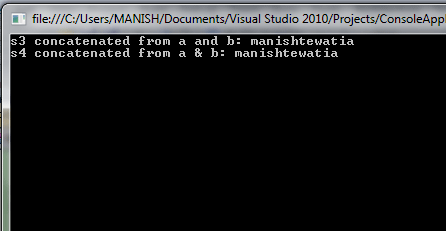
In next example the Copy function returns a new string.
Example of String.Copy
Imports System
Imports System.Collections
Public Class MainClass
Shared Sub Main()
Dim a As String = "manish"
Dim b As String = "tewatia"
' the String copy method
Dim c As String = String.Copy(a)
Console.WriteLine("a copied from b: {0}", a)
' use the overloaded operator
Dim d As String = b
Console.WriteLine("a = b: {0}", b)
Console.ReadLine()
End Sub
End Class
Output
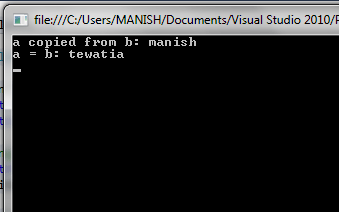
In the next example the CopyTo function copies a part of one string to another string.
Example of String.CopyTo
Imports System
Public Class MainClass
Shared Sub Main()
Dim string1 As String
Dim characterArray As Char()
Dim i As Integer
Dim quotes As Char = ChrW(34)
string1 = "manish tewatia"
characterArray = New Char(6) {}
Console.WriteLine("string1: " & quotes & string1)
Console.WriteLine(" copy characters from string1 into characterArray ")
string1.CopyTo(0, characterArray, 0, 6)
Console.WriteLine("The character array is: ")
For i = 0 To characterArray.GetUpperBound(0)
Console.WriteLine(characterArray(i))
Next
Console.ReadLine()
End Sub ' Main
End Class
Output
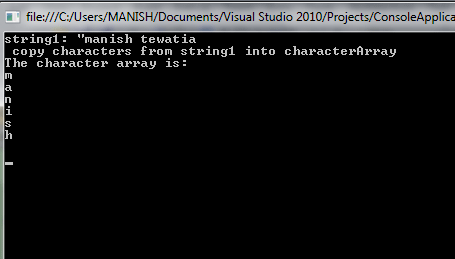
The next example expail the EndsWith function
Example of String.EndsWith
Imports System
Public Class MainClass
Shared Sub Main()
Dim river As String = "manish"
Console.WriteLine(river.EndsWith("h"))
Console.WriteLine(river.EndsWith("i"))
Console.ReadLine()
End Sub
End Class
Output
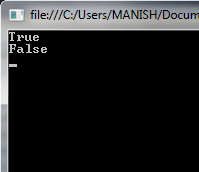
The Format static function helps in formating strings containing numbers, dates, strings, and much more. Using the Format method you can pass in objects of different types and have them neatly inserted into your string. You can also handle column alignment and column width in the string. Below is a example of Format method.
Example of String.Format
Imports System
Public Class MainClass
Shared Sub Main(ByVal args As String())
Dim amount, principal As Decimal ' dollar amounts
Dim rate As Double ' interest rate
Dim year As Integer ' year counter
Dim output As String ' amount after each year
principal = 3000
rate = 0.09
output = "Year" & vbTab & "Amount deposit" & vbCrLf
' calculate amount after each year
For year = 1 To 5
amount = principal * (1 + rate) ^ year
output &= year & vbTab & _
String.Format("{0:C}", amount) & vbCrLf
Next
' display output
Console.WriteLine("Compound Interest" & output)
Console.ReadLine()
End Sub
End Class
Output
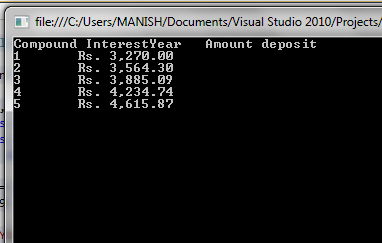
Conclusion
Hope this article would have helped you in understanding the important Member Functions in VB.NET. Reaming function I will describe in next article.